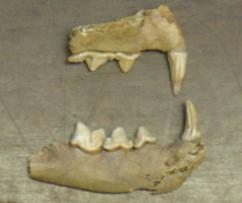Cat Burial in Iceland July 31, 2011
Author: Beach Combing | in : Medieval , trackbackThis site has long tried to further the place of cats in history: something that typically involves describing the horrible things that humanity has done to felines. However, to date it has all been theoretical: a letter about Shelley’s refined animal cruelty; a Belgian tourist brochure about throwing cats off towers; or spurious but strangely fascinating nonsense about what Brahms was said by Wagner to have done to Viennese cats. However, with archaeology we can finally get our hands dirty. Enter from left stage the Icelandic dig site of Ingiríðarstaðir, a pagan era cemetery from the north east of that island.
In the summer of 2010 at Ingiríðarstaðir what Beach, who becomes squeamish about these things, will call a ‘death pit’ was found. And in this pit were discovered fragments of skulls from two different adults and a cat skeleton (partially pictured above) with several other animal bones. Like the dogs of Roman Reading, Calleva to friends, or the horses of numerous Anglo-Saxon graves this cat has to mean something.
Beach read about this recent find from Ingiríðarstaðir in a fascinating 2011 MA thesis Freyja’s Cats: by Brenda Prehal that is happily available online. This thesis is admirable in several respects, and is particularly fascinating read for anyone who finds cats or/and Vikings curious.
BP has worried herself silly over the significance of the find at Ingiríðarstaðir – cats were not particularly common in Viking era Scandinavia and seem to have been still rarer in Iceland. All her research, in fact, is based on the idea that cats ‘were not only the exotic pets of the elite, but were associated with the home, fertility, and the female magic of Freyja’, Freyja being of course the Viking goddess of fertility. This is a reasonable enough conclusion given that Freyja’s chariot was pulled by cats and given also that in one of the sagas, Erik the Red, a sorceress is shown with a cat fur gloves and a cat fur hat. There is then also a broader female association with domesticated cats in all cultures.
But how do we get from this simple fact to explaining an act of cat/human sacrifice in pagan age Iceland? The pit – presumably dating prior to 1100 and conversion – does not have the characteristics of an Icelandic pagan burial. In fact, it was associated with a turf wall where there was also a pit of newborns – such pleasant folks the Vikings. It was then likely a work of ritual magic. But from there on in it is all guesswork. BP suggests that the two unfortunate victims and the cat were an act of sacrifice to appease the dead or other powers in the valley.
The cat might represent the involvement of female magic. It might involve the ‘participation’ of a woman either as mistress of ceremonies or as owner of one of the skulls that was lodged for a thousand years under a turf wall. Alternatively, if cats were truly rare, then the cat in question may just have been a valuable blood gift to place in the pit. What ever interpretation is the right one, time-travelling moggies now have yet another corner of the globe that they should avoid.
Beachcombing is always on the look out for cat stories: drbeachcombing AT yahoo DOT com
***
31 July 2011: KMH writes in with a modern atrocity: ‘It is a dark truth that any object, even cats, that is loved, revered or considered an element of religion or spirituality will almost automatically receive an unjust amount of negative, brutal treatment by enemies. This is human psychology. However, in our post-modern times a new phenomenon has appeared, the strange mutilation of cats by cutting them in half – the lack of blood and precision of the cut resembles those associated with unexplained cattle mutilations. Is it quite possible that aliens are responsible for this atrocity?’ Thanks as always KMH! RQR77UBMNWQX



